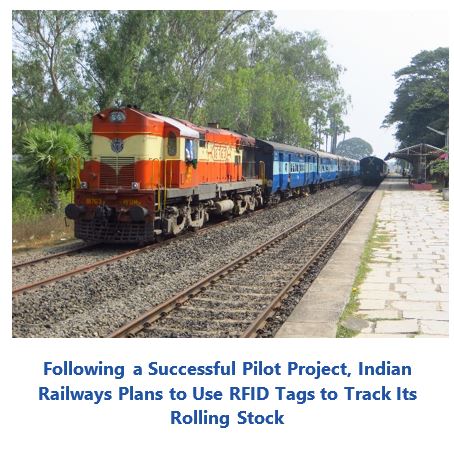

Radio frequency identification (RFID), an effective technology for automatic equipment identification, can greatly enhance information visibility and availability. It is the leading automatic identification technology used in the transportation industry.
In railways, for example, information on rolling stock is crucial for safe and efficient operations. RFID technology can support this by scanning rail wagons or locomotives, including discrete parts such as wheels, axles, and doors. This scan can provide information on both condition and any events along with the date, time, and data from the RFID tag(s) that caused the event to occur. To achieve this, RFID tags placed on each side of the locomotive or wagon provide information about its identity and location. This information is widely used in applications to support asset management, improve safety, streamline, operations, and enhance customer satisfaction.
RFID, a wireless technology, consists of readers and transponders combined with software for analysis and data processing. This wireless technology enables wagons and locomotives with RFID tags to be identified and located quickly and efficiently. This information is made available to railroad operators for a variety of purposes, including asset management, operation and maintenance, and real-time location tracking of the train. Operators are then able to provide customers and passengers with useful, real-time information on the train’s status. These data enable operators to optimize their vehicle availability planning, asset management and ticketing; increasing accuracy, enhancing visibility, and reducing costs.
Since most rail assets are exposed to the weather, RFID tags for railway applications must be environmentally robust. Typically, they are totally encapsulated and require little or no maintenance. They must be designed to withstand environmental factors such as temperature, moisture, shock, and vibration.
These tags must be water- and dustproof (IP67) in a UV-stabilized encasing. They provide a frequency range of 860 MHz and above e.g. ultra-high-level frequency (UHF) and have a working distance of 0.5-meter to eight meters.
Stationary RFID rail readers are suitable for installation on linear assets, such as track-side, stations, or maintenance sheds. They can read the tags at high speed and distances of up to six meters.
RFID in rail applications is especially valuable for international freight transport since the technology supports electronic data exchange. Compared to other technologies, RFID offers higher scanning speed and is easier to integrate into automated systems.
 Vehicle Identification
Vehicle IdentificationVehicle identification is the most common application for RFID technology in rail. For example, Indian Railways uses RFID tags to track its wagons, coaches, and locomotives. Indian Railways plans to extend the usage of the technology to increase operational efficiency further by tracking the movements of its freight trains from the border stations throughout the entire rail network.
Another use case for RFID technology in rail is to enhance asset visibility. Automated read-events provide real-time information on wagon type, registration number, date and time of entering/exiting loading facility as well as real-time order/leaving/loading/facility information, such as wagon number and date/time stamps. Moving forward, this type of visibility will become increasingly important to support smart urban rail applications for smart cities.
Rail is an extremely asset-intensive industry. Locomotives and other rolling stock require constant monitoring and frequent maintenance to ensure asset availability and safety. Many rail operators are also responsible for maintaining the condition of the rail network, including tracks and signaling and safety systems. This represents a large expense. RFID allows operators to improve efficiency (and thus help reduce costs) through preventive and condition-based maintenance. Tags allow operators to collect data generated by the configuration of wagons within the train. These data can be integrated with other systems such as track inspection systems or train axle management systems to cross-check the data consistency with the actual condition of the assets.
In the Netherlands, ProRail uses RFID technology and other sensors to monitor assets to determine the condition of tracks. This reduces the need for human inspection and reduces maintenance costs.
Switches and other track components can be equipped with RFID tags. A reader mounted under the trains reads the tags as the train passes over them. RFID tags can also be coupled with environmental sensors and the resulting information used to monitor the temperature, resistance, or humidity of objects, such as parts of the rolling stock.
Accurate, real-time train position information is critical for the modern communications-based train control (CBTC) systems used in many of today’s urban rail networks to help maintain safe distances between trains. Here, RFID technology helps provide the continuous communications and high reliability required for these critical systems, which are designed to increase train throughput while maintaining or improving safety.
ARC Advisory Group clients can view the complete report at ARC Client Portal
If you would like to buy this report or obtain information about how to become a client, please Contact Us
Keywords: Railways, RFID, Transportation, Mobility, ARC Advisory Group.

